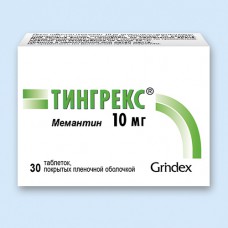Expiration date: 03/2026
Pharmacological action
Adamantane derivative, the chemical structure and pharmacological properties similar to amantadine. Being a non-competitive antagonist of N-methyl-D-aspartate (NMDA) receptors, exerts a modulatory action on glutamatergic system. Regulates ion transport, blocks the calcium channels normalizes the membrane potential, improves the process of transmission of nerve impulse. Improves cognitive processes, increases daily activity.
Pharmacokinetics
Suction
Eating does not affect the removals. After intake of memantine is rapidly and completely absorbed from the gastrointestinal tract. Cmax in plasma is reached within 3-8 hours after administration of a single dose.
Distribution
A daily intake of a daily dose of 20 mg leads to Css of memantine in plasma 70-150 ng/ml When using a daily dose of 5-30 mg, the ratio of the average concentration in the cerebrospinal fluid to the concentration in blood plasma equal to 0.52. Vd is about 10 l/kg. About 45% of memantine are associated with blood plasma proteins.
Studies conducted in volunteers showed that the pharmacokinetic profile is linear in the dose range of 10-40 mg.
Metabolism
80% circulating in the blood of memantine presented by the unmodified substance. The main metabolites are N-3,5-dimethylhydantoin, isomeric mixture of 4 and 6?gidroksilamina and 1 nitroso-3,5-dimethyladamantane. None of the metabolites has no antagonistic activity against NMDA-receptors, i.e. has no pharmacological activity. The participation of cytochrome P450 catalysed metabolism has been detected in vitro.
Excretion
Memantine is excreted primarily by the kidneys with urine. Excretion occurs single-phase, T1/2 is 60 to 100 h. in volunteers with normal renal function total clearance amounts to 170 ml/min/1.73 m2. Part of total renal clearance is achieved by tubular secretion. Renal excretion also involves tubular reabsorption, probably mediated by cation transport proteins. In alkaline urine the excretion is slowing down (on average by 80% when urine pH 8). Alkalinisation of the urine can be caused by a change of diet, for example, the transition from a diet including animal products to a vegetarian diet, or due to intensive use of alkaline gastric buffers.
When the normal renal function of drug accumulation is not observed.
Pharmacokinetic/pharmacodynamic dependence
The application of memantine at a dose of 20 mg/day concentration in cerebrospinal fluid corresponds to the magnitude of the inhibition constants (Ki) that memantine is 0.5 µmol in the region of the frontal cortex of the brain.
Testimony
- dementia of Alzheimer's type moderate and severe.




